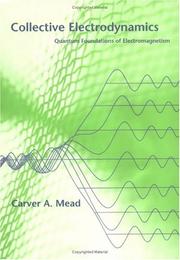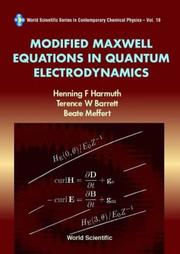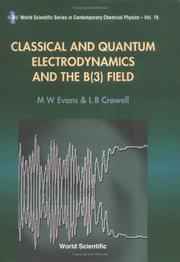| Listing 1 - 10 of 54 | << page >> |
Sort by
|

ISBN: 0262279606 0585436959 9780262279604 9780585436951 0262133784 9780262133784 0262632608 9780262632607 Year: 2000 Publisher: Cambridge, Mass. MIT Press
Abstract | Keywords | Export | Availability | Bookmark
 Loading...
Loading...Choose an application
- Reference Manager
- EndNote
- RefWorks (Direct export to RefWorks)
In this book Carver Mead offers a radically new approach to the standard problems of electromagnetic theory. Motivated by the belief that the goal of scientific research should be the simplification and unification of knowledge, he describes a new way of doing electrodynamics--collective electrodynamics--that does not rely on Maxwell's equations, but rather uses the quantum nature of matter as its sole basis. Collective electrodynamics is a way of looking at how electrons interact, based on experiments that tell us about the electrons directly. (As Mead points out, Maxwell had no access to these experiments.) The results Mead derives for standard electromagnetic problems are identical to those found in any text. Collective electrodynamics reveals, however, that quantities that we usually think of as being very different are, in fact, the same--that electromagnetic phenomena are simple and direct manifestations of quantum phenomena. Mead views his approach as a first step toward reformulating quantum concepts in a clear and comprehensible manner. The book is divided into five sections: magnetic interaction of steady currents, propagating waves, electromagnetic energy, radiation in free space, and electromagnetic interaction of atoms. In an engaging preface, Mead tells how his approach to electromagnetic theory was inspired by his interaction with Richard Feynman.
Quantum electrodynamics. --- Electrodynamics, Quantum --- QED (Physics) --- Quantum field theory --- Schwinger action principle --- PHYSICAL SCIENCES/General
Book
ISBN: 1620815192 9781620815199 9781620814840 1620814846 Year: 2013 Publisher: [Hauppauge] N.Y. Nova Publishers
Abstract | Keywords | Export | Availability | Bookmark
 Loading...
Loading...Choose an application
- Reference Manager
- EndNote
- RefWorks (Direct export to RefWorks)
Quantum electrodynamics --- Electrodynamics, Quantum --- QED (Physics) --- Quantum field theory --- Schwinger action principle --- Research.
Book

ISBN: 9814460354 9789814460354 9789814460347 9814460346 Year: 2014 Publisher: New Jersey
Abstract | Keywords | Export | Availability | Bookmark
 Loading...
Loading...Choose an application
- Reference Manager
- EndNote
- RefWorks (Direct export to RefWorks)
The physics of strong light-matter coupling has been addressed in different scientific communities over the last three decades. Since the early eighties, atoms coupled to optical and microwave cavities have led to pioneering demonstrations of cavity quantum electrodynamics, Gedanken experiments, and building blocks for quantum information processing, for which the Nobel Prize in Physics was awarded in 2012. In the framework of semiconducting devices, strong coupling has allowed investigations into the physics of Bose gases in solid-state environments, and the latter holds promise for exploitin
Quantum optics. --- Quantum electrodynamics. --- Electrodynamics, Quantum --- QED (Physics) --- Quantum field theory --- Schwinger action principle --- Optics --- Photons --- Quantum theory
Book
ISBN: 1536104817 9781536104813 9781536104677 Year: 2017 Publisher: Hauppauge, New York
Abstract | Keywords | Export | Availability | Bookmark
 Loading...
Loading...Choose an application
- Reference Manager
- EndNote
- RefWorks (Direct export to RefWorks)
Quantum electrodynamics. --- Biophysics. --- Biological physics --- Biology --- Medical sciences --- Physics --- Electrodynamics, Quantum --- QED (Physics) --- Quantum field theory --- Schwinger action principle
Book
ISBN: 0306402777 1475706731 1475706715 Year: 1980 Publisher: London Plenum
Abstract | Keywords | Export | Availability | Bookmark
 Loading...
Loading...Choose an application
- Reference Manager
- EndNote
- RefWorks (Direct export to RefWorks)
Quantum electrodynamics --- Radiation --- 530.1 --- Physics --- Radiology --- Electrodynamics, Quantum --- QED (Physics) --- Quantum field theory --- Schwinger action principle --- Basic principles of physics --- 530.1 Basic principles of physics
Book
ISBN: 1281258555 9786611258559 2759801357 1417561394 9781417561391 9781281258557 9782759801350 Year: 2001 Publisher: Les Ulis, France : EDP Sciences,
Abstract | Keywords | Export | Availability | Bookmark
 Loading...
Loading...Choose an application
- Reference Manager
- EndNote
- RefWorks (Direct export to RefWorks)
This work provides a necessary overview of the quantum description of electromagnetic field in order to understand the various physical processes associated with those photon-atom interactions appearing in atom and molecular physics, quantum optics and laser physics.
Quantum electrodynamics. --- Photons. --- Atoms. --- Chemistry, Physical and theoretical --- Matter --- Stereochemistry --- Light quantum --- Light --- Einstein-Podolsky-Rosen experiment --- Electrodynamics, Quantum --- QED (Physics) --- Quantum field theory --- Schwinger action principle --- Constitution

ISBN: 1281947970 9786611947972 9812799656 9789812799654 9789810247706 9810247702 9781281947970 Year: 2001 Publisher: New Jersey World Scientific
Abstract | Keywords | Export | Availability | Bookmark
 Loading...
Loading...Choose an application
- Reference Manager
- EndNote
- RefWorks (Direct export to RefWorks)
Divergencies in quantum field theory referred to as "infinite zero-point energy" have been a problem for 70 years. Renormalization has always been considered an unsatisfactory remedy. In 1985 it was found that Maxwell's equations generally do not have solutions that satisfy the causality law. An additional term for magnetic dipole currents corrected this shortcoming. Rotating magnetic dipoles produce magnetic dipole currents, just as rotating electric dipoles in a material like barium titanate produce electric dipole currents. Electric dipole currents were always part of Maxwell's equations.
Maxwell equations. --- Quantum electrodynamics. --- Electrodynamics, Quantum --- QED (Physics) --- Quantum field theory --- Schwinger action principle --- Equations, Maxwell --- Differential equations, Partial --- Electromagnetic theory

ISBN: 1281960799 9786611960797 9812811907 9789812811905 9789810241490 9810241496 9781281960795 6611960791 Year: 2001 Publisher: Singapore River Edge, N.J. World Scientific
Abstract | Keywords | Export | Availability | Bookmark
 Loading...
Loading...Choose an application
- Reference Manager
- EndNote
- RefWorks (Direct export to RefWorks)
It is well known that classical electrodynamics is riddled with internal inconsistencies springing from the fact that it is a linear, Abelian theory in which the potentials are unphysical. This volume offers a self-consistent hypothesis which removes some of these problems, as well as builds a framework on which linear and nonlinear optics are treated as a non-Abelian gauge field theory based on the emergence of the fundamental magnetizing field of radiation, the B(3) field.
Contents:
- Interaction of Electromagnetic Radiation with One Fermion
- The Field Equations of Cl
Electrodynamics. --- Quantum electrodynamics. --- Quantum theory. --- Quantum dynamics --- Quantum mechanics --- Quantum physics --- Physics --- Mechanics --- Thermodynamics --- Electrodynamics, Quantum --- QED (Physics) --- Quantum field theory --- Schwinger action principle --- Dynamics
Book
ISSN: 17930758 ISBN: 981446015X 9789814460156 1299713602 9781299713604 9789814460149 9814460141 Year: 2013 Volume: 24 Publisher: Hackensack, NJ World Scientific
Abstract | Keywords | Export | Availability | Bookmark
 Loading...
Loading...Choose an application
- Reference Manager
- EndNote
- RefWorks (Direct export to RefWorks)
This volume is based on lectures given during the program Complex Quantum Systems held at the National University of Singapore's Institute for Mathematical Sciences from 17 February to 27 March 2010. It guides the reader through two introductory expositions on large Coulomb systems to five of the most important developments in the field: derivation of mean field equations, derivation of effective Hamiltonians, alternative high precision methods in quantum chemistry, modern many body methods originating from quantum information, and - the most complex - semirelativistic quantum electrodynamics.
Quantum statistics. --- Quantum electrodynamics --- Electrodynamics, Quantum --- QED (Physics) --- Quantum field theory --- Schwinger action principle --- Quantum statistical mechanics --- Matrix mechanics --- Statistical mechanics --- Wave mechanics --- Mathematics. --- Quantum theory

ISBN: 9780511535178 9780521836975 9780521037075 0511210795 9780511210792 0521836972 0511216165 9780511216169 0511212569 9780511212567 0511214375 9780511214370 0511535171 1280540095 9781280540097 9786610540099 6610540098 0511315066 9780511315060 0521037077 110715023X Year: 2004 Publisher: Cambridge, UK New York Cambridge University Press
Abstract | Keywords | Export | Availability | Bookmark
 Loading...
Loading...Choose an application
- Reference Manager
- EndNote
- RefWorks (Direct export to RefWorks)
This book provides a self-contained and systematic introduction to classical electron theory and its quantization, non-relativistic quantum electrodynamics. The first half of the book covers the classical theory. It discusses the well-defined Abraham model of extended charges in interaction with the electromagnetic field, and gives a study of the effective dynamics of charges under the condition that, on the scale given by the size of the charge distribution, they are far apart and the applied potentials vary slowly. The second half covers the quantum theory, leading to a coherent presentation of non-relativistic quantum electrodynamics. Topics discussed include non-perturbative properties of the basic Hamiltonian, the structure of resonances, the relaxation to the ground state through emission of photons, the non-perturbative derivation of the g-factor of the electron and the stability of matter.
Electromagnetic theory. --- Quantum electrodynamics. --- Electrodynamics, Quantum --- QED (Physics) --- Quantum field theory --- Schwinger action principle --- Light, Electromagnetic theory of --- Electric fields --- Magnetic fields
| Listing 1 - 10 of 54 | << page >> |
Sort by
|

 Search
Search Feedback
Feedback About UniCat
About UniCat  Help
Help News
News